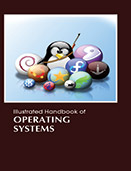Computer Science

An operating system is software which has a wide range of definition and is considered as a bridge between human command and hardware response. In layman’s terms, an operating system may best be summarizes as the spirit and mind which makes objects made of silicon and wire come alive on the screen. It can be as basic as software interacting with simple hardware installed in kids’ toys. What complicates operating systems is that it has the capability to respond to human command which is called intelligent operating. Since there are many operating systems invented to perform certain tasks, this book focuses on operating systems which work on computers, whether it is a personal computer or a mainframe computer.
Illustrated Handbook of Operating Systems gives students a general view about the most famous operation system, taking into consideration both advantages and disadvantages.
In the current environment, companies developing the largest systems face an unappealing dilemma: they can adopt a full-featured operating system at the risk of hindering application scalability, or they can adopt a lightweight operating system that does not support the broader application community. The possibility of supporting both a full-featured operating system and supporting a lightweight operating system is financially infeasible.
The main focus of this Illustrated Handbook of Operating Systems is to foster an understanding of operating system fundamentals: what types of services they provide, how various applications interface with them, and the restrictions they have on those applications.
There are many operating systems developed in the world; some of them are for private at home or school, some are for government use, such as in the military, while others are distributed in the marketplace on a wider scale for businesses. The most well-known released operating systems are Window, Mac, UNIX, and Linux. Users pick out the operating system. As a consequence, each operating system has a strong and weak side which makes it unique and diverse; these minute elements of diversity distinguish them from their competitors. However, many elements play a major role that affect people’s denervation. These factors generally include: user-friendliness, cost, support, confidentiality, integrity, capability, and availability